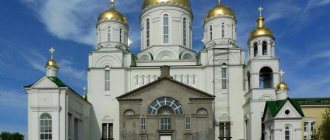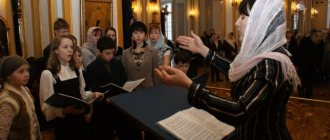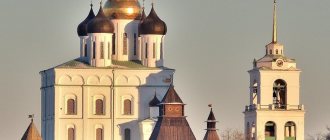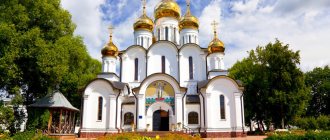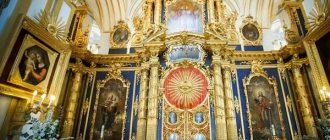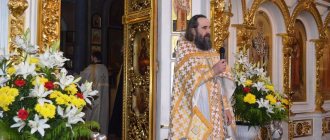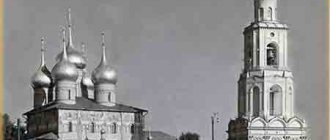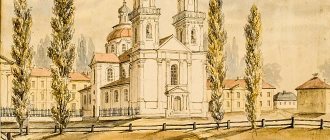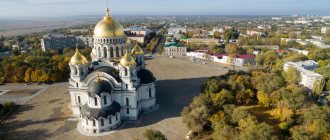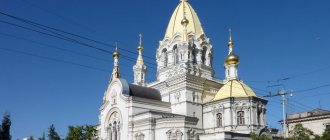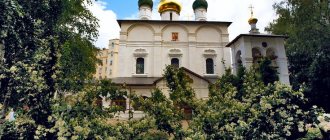The Naval Cathedral of St. Nicholas the Wonderworker (full name - Stavropegial St. Nicholas Naval Cathedral of the city of Kronstadt) is the largest naval cathedral of the times of the Russian Empire, recognized as a UNESCO World Heritage Site. Today it is the main naval temple of Russia.
St. Nicholas Naval Cathedral was built in the fortified city of Kronstadt by decree of Nicholas II in 1903. The emperor himself was present at the laying of the first stone, and after the ceremony, together with his entourage, he planted 32 oak trees in the park near the cathedral.
The story of the birth of a masterpiece
And it all started under Peter 1
The first small church for sailor parishioners was built here from wood by decree of Peter 1, who founded the base of the Russian fleet in the city. Over time, it became dilapidated and was dismantled and replaced with a new one, but the same wooden one.
The city expanded, the population grew. This was mainly due to the increase in the power of the Russian fleet and the constant influx of young people of different classes into it.
In 1830, the question began to be raised that the city needed a more spacious church, the main parishioners of which would be sailors. This problem has been solved for almost 70 years!!!
The new project has been highly approved
Vice Admiral Kaznakov's request was approved only at the very end of the 19th century. This made it possible to start a subscription campaign to collect feasible donations, which would go towards the construction of a large naval cathedral in Kronstadt.
This large-scale project was headed by a representative of the naval clergy A. Zhelobovsky, who initiated the construction of hundreds of military churches throughout Russia. It didn’t take long to find a place for the grandiose construction.
It became a huge square with a suitable name - Yakornaya. On its vast territory, for a long time old anchors, already covered in rust in places, lay like small monuments.
The territory was so large that even after the appearance of the temple of sailors here, it was possible to build a park around it, as well as the necessary platform for parades and religious processions, mandatory in such cases.
Temple, monument and lighthouse - these are the conditions
According to the designers, in the future the temple had to meet several conditions. It was assumed that it would be high enough so that the cross rising on it would become a kind of lighthouse - a guide for seafarers.
And of course, in addition to the fact that the temple would be a place of prayer for the military living here and all residents of the city, it was also, in theory, supposed to become a stone keeper of the memory of the brave sailors who died heroically.
For four long years, under the leadership of V.A. Kosyakov, the project was developed. Two more engineers, civilians Viksel and Shavernovsky, took an important part in the work on it.
Start of construction
In the first half of 1901, the long-term project was finally approved. And in September 1902, the first stone was laid for the construction of a new church, which later became the largest cathedral for employees of the Russian Navy.
Before the start of construction, a prayer service was served by the priest of the Orthodox Church, John of Kronstadt. Immediately after the prayer service, a fireworks display consisting of 31 shots was fired. It was fired from guns located on the city fortress and on ships stationed in the bay.
After this, Nicholas 2, who was present at the ceremony, together with his family and with the participation of his immediate circle, planted 32 oak seedlings in the already planned public garden.
Price issue
In 1907, the external construction of the huge cathedral was completed. It was time to start decorating its interior. According to existing documents, construction cost almost 2 million rubles!
John of Kronstadt collected a lot of money. There is historical information that his total contribution was 700 rubles. And that was a lot of money at that time!
The life of Holy Father John was filled with good deeds. People respected the priest and, having heard about the miracles he performed, donated large sums to the temple. After the mandatory consecration of the temple in 1913, divine services began to be held there.
Difficult 20th century
The power has changed...
The new Soviet government came, and in 2022 the cathedral was nationalized. All his property was transferred to the state. But services continued until 1929. After this, all religious services were banned, and the temple itself was closed.
A few months later in 1930, a demonstration was held on Yakornaya Street, during which heavy bells and gilded crosses were roughly thrown from the temple.
And in the empty, former church building, they equipped a cinema, which local residents immediately nicknamed Maksimka, because it bore the name of Maxim Gorky.
So that nothing would remind of the splendor that reigned here before, the gilding was removed from the domes, the icons were broken, and the marble iconostasis was dismantled piece by piece. The mosaic icons and amazingly beautiful paintings on the walls were carefully plastered over, and all the property was carried away in all directions, or rather, stolen.
Inside the temple there were also memory boards made of pure black and white marble. On the black ones, military sailors who gave their lives to the Fatherland while serving were marked by name. And on the white ones - clergymen who faithfully served on military ships and died heroically are marked. And these memorial plaques were also taken away to later be used on the farm - instead of electrical panels, steps, and so on.
The next test is war
During the war years, an observation and coordinating artillery post was created under the very dome of the tall building.
This attracted the attention of the Nazis to him, and during the shelling, of course, shells hit him, which significantly damaged the Naval St. Nicholas Cathedral of Kronstadt. Much later, during the restoration of the cathedral, they decided to deliberately leave some of the damage.
In the post-war 50s, the partially destroyed church housed a spacious concert hall with a balcony and a large stage, which was somehow equipped on the site of the once magnificent iconostasis. The space under the dome was separated by a ceiling.
The hall itself was very large; it could accommodate 1250 spectators at the same time. A club dedicated to the city fortress was also organized here.
This went on for more than two decades. By 1974, the temple was more or less restored and a branch of the Naval Museum was opened in it. Another 30 years passed, and the situation began to change.
Information for visitors
Address of the Naval St. Nicholas Cathedral : Russia, St. Petersburg, Kronstadt, Anchor Square, 1.
Opening hours : daily from 9.30 to 18.00.
Divine services are held twice a day: at 10.00 and at 18.00.
*When writing the article, materials from the book by V.Ya. Krestyaninov “Kronstadt. Fortress, city, port", St. Petersburg, 2014.
© Website “On the Roads of the Middle Way”, 2009-2021. Copying and reprinting of any materials and photographs from the site anashina.com in electronic publications and printed publications is prohibited.
The time has come for the revival of the temple
The first services have passed
In 2002, an Orthodox holy cross was installed above the temple bell tower, but for several years the status of the building was in question. In any case, it did not belong to the church diocese.
And only at the very end of 2005, a liturgy was held in the church for the first time in many years. The cathedral was slowly restored. On weekends and Christian holidays, in parallel with restoration work, divine services were held.
In 2009, the temple was completely surrounded by scaffolding and covered with a special protective film.
Feast of Consecration
After all the large-scale work on the revival of the Naval Cathedral, on May 28, 2013, Patriarch Kirill personally, together with Patriarch Theophilus of Jerusalem, conducted the consecration ceremony of the Kronstadt Naval Cathedral in the name of the patron saint of sailors, Nicholas the Wonderworker.
A festive parade of military personnel took place on the adjacent square. The patriarch brought a magnificent icon to the revived cathedral: the Resurrection of Lazarus.
From the eminent guests of the holiday, the cathedral received a particle of the relics of St. Nicholas, myrrh, as well as a copy of the icon lamp, which for many years has stood in the crypt of the small church of the saint in the Italian port city of Bari, of which he is considered the patron saint.
In addition, particles of the relics of all twelve apostles and also a particle of the Life-giving Cross of the Lord appeared in the temple. And literally the very next day the cathedral received a high status - stauropegial.
And on April 30, 2014, the rector of the Naval Cathedral in Kronstadt was appointed. This was Archimandrite Alexy (Ganzhin).
Interesting facts about the Naval Cathedral in Kronstadt
In the history of the Naval Cathedral you can find many interesting facts that speak about its uniqueness. The most mystical facts, perhaps, concern the connection of times. Thus, the end of the restoration, for example, coincided with the 100th anniversary of the temple.
Moreover, just like 100 years ago, Russian sailors helped restore the cathedral. 16 thousand families of military sailors responded to the call of the Navy command to help with the restoration of the cathedral. But this is not surprising. Of course, the ruble exchange rate is not the same as 100 years ago. It is symbolic that the amount collected for restoration today completely coincides with that which our ancestors donated for construction.
Each Orthodox church in Russia is unique in its own way. But the Naval Cathedral in Kronstadt occupies a special place among them. It is truly unique in many ways. I would like to believe that the revival after a hundred years of a temple that shared the fate of its country is a good sign for Russia.
Author: Irina Zhuravka
Article design: Ilchenko Oksana
The beauty and uniqueness of the cathedral
Similar to Sofia, but still ours, Russian
“Russian Sophia” is sometimes the name of the main naval cathedral. In fact, in Kronstadt there is St. Nicholas Cathedral. After all, it was consecrated in the name of St. Nicholas, although it is very similar to Istanbul. And Kronstadt is the largest naval cathedral. And, as time has shown, the very last one that arose in the Russian Empire.
As they write in various sources, the cathedral is very similar to the St. Sophia Temple, located in Constantinople. There is even a legend that Kosyakov made a special trip to this Turkish city to take a closer look at the building’s plan.
But it didn’t seem so to me when I was in Istanbul and saw this Church of St. Sophia. Perhaps it is somehow similar internally or due to its enormous scale, but I did not notice much external similarity.
The Kronstadt Cathedral is still a little smaller, but no less beautiful! Its height is more than 70 meters!
It seemed to me even more similar to another “foreign” cathedral, consecrated in honor of the Apostle Andrew the First-Called, which was built on the site of his death: in the Greek city of Patras.
Marine theme of the Orthodox church
External beauty
The maritime orientation is visible in the decoration of the cathedral even from afar. Its dome is made of copper. For a long time it was blue with a green tint.
But now, if you look at the top view, it is silver with ornate patterns depicting gold knots and anchors.
The cross on the dome, one might say, is inscribed in the circumference of the steering wheel, and the dome itself is decorated with beautifully intertwined patterns.
You can also admire the ornate patterns on the walls of the Naval Cathedral. Thanks to them, the church looks very elegant and airy.
It is no coincidence that the names of the saints in whose honor the temple was erected were chosen. The chapel to the left of the main entrance is dedicated to the apostles Peter and Paul. This serves as a reminder of the creator of the great Russian fleet - Peter 1.
The central chapel bears the name of the patron saint of sailors, Nicholas the Wonderworker. The right side chapel is dedicated to St. John of Rila, the heavenly patron of holy rights. John of Kronstadt.
The temple has its own secret. If we look at its plan, we will see that it has 2 domes: internal and external. So, the inner dome resembles an inverted sea compass.
and internal
The marine theme in the interior and exterior of the cathedral is harmoniously intertwined with religious symbols.
For example, the St. Andrew's flag is located near the altar, and the large dome crowning the Kronstadt Naval Cathedral is decorated with 12 molded anchors with steering wheels.
The huge windows decorated with stained glass deserve special attention. They have a round shape and resemble portholes.
There were a total of 5 such glass panels in the temple. 2 of them were simply colossal in size - 52 square meters each. meters. There is no doubt that before the revolution these were the largest stained glass windows in Russia.
There are 32 windows distributed around the perimeter of the building. This is exactly how many points of reference the compass circle contains.
Inside the temple is simply huge and looks luxurious. Its light walls and high domes give the space some solemnity and elegance. 2 half-domes are connected to the central dome, thereby creating the impression of endless space around.
By the way, such an extraordinary plan of the cathedral allows you to see and hear divine services perfectly from anywhere in the temple, even despite its colossal size. By the way, it can freely accommodate 5,000 people at the same time!
The floor is made of multi-colored marble, which depicts magnificent animals, fish, birds and sea creatures. All this is intertwined with a beautiful ornament.
The ceiling of the temple rises 52 meters and has a diameter of 27 meters. It is also decorated with magnificent paintings.
There are stone columns around the perimeter of the cathedral. In some way they reminded me of St. Isaac's Cathedral in St. Petersburg. Each of them has its own decoration on top.
Temple-memorial
The temple houses black marble boards on which the names of the heroes of the sea who died in military service are immortalized. White marble boards also serve the same sad function. The names of 14 clergymen who served on ships and heroically died were carved on them. They are located near the altar.
The boards were restored in the likeness of pre-revolutionary ones, which were destroyed in the 30s. The list of heroes who fell in office ends with 1917. It is clear that not all names are here. It is known that about 40 thousand naval officers died in wartime alone.
For some time, icons and standards from ships that had already been decommissioned were kept in the cathedral. Another rarity has been preserved here: some sketches of the building with the personal signature of Kosyakov, the chief architect of the Naval Cathedral. Here you can also look at a scaled-down model of the temple.
One of the temple bells weighed 4840 kilograms. He could not be thrown to the ground, like others, with the advent of Soviet power. So he remained in his place. And during the Second World War, before the start of shelling, observers sometimes rang this bell, warning residents. Now the bell has been restored, and it continues to delight parishioners with its ringing, being in its unchanged place.
And during the war years, a sidereal clock with a complex mechanism was brought from the famous Pulkovo Observatory to the basement of the cathedral for preservation.
Now an innovation has appeared in the Naval Cathedral of St. Nicholas. In addition to the usual church paraphernalia, there are various art and historical exhibitions here.
We looked at exhibits from the Central Naval Museum and the State Museum of the History of Religion.
Also on display were stands telling about the life of the holy righteous father John of Kronstadt, who lived in this city for more than 50 years. He served in St. Andrew's Church, which was located near the Naval Cathedral. Rare photographs of the priest are presented.
And another interesting fact: the Naval St. Nicholas Cathedral is officially recognized as a UNESCO World Heritage Site and is protected by the state.
Architectural features of the cathedral
Just like 100 years ago, the dome of the cathedral is crowned with a restored gilded cross. Located at a height of 70 meters, it is visible to sailors hurrying home from a distance of 30 miles. The silvery sky-blue domes are decorated with anchors and lifebuoys made of gilded bronze. On the heavy entrance doors there are images of outlandish fish.
The use of maritime symbols is not only a tribute to the fact that the temple was built for sailors. Even in the apostolic decrees of the 1st century, there are special instructions regarding the construction of Christian churches: to build them like ships. This idea goes back to the image of Noah's Ark, symbolizing salvation. The gigantic building was constructed using the latest technology of the time.
The original project also delights today's builders who restored the cathedral. The dome structure is movable. The metal trusses on which the wood sheathing is constructed are not static, as the hinged supports were installed on a rigid base. This risky design option became a brilliant solution given the large windage of the dome and the enormous wind load.
The mobility of the upper part of the building made it possible to smoothly escape from strong wind blows. Another interesting engineering solution by Vasily Kosyakov was the intersecting arches of the vault. This made it possible to free up the internal space from unnecessary supports, thereby increasing the internal area of the building.
Attractions nearby
Everyone who comes here first ends up on Anchor Square. This is a huge space in front of the temple. We were in Kronstadt after the New Year, so the main object on the square was the New Year tree.
